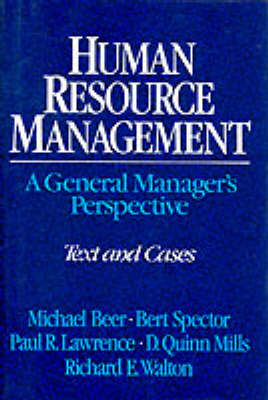International competitive pressures, the increasing size and complexity of organizations, the changing values, career concerns, and demography of the work force -- these and a host of other factors have made the modern corporation's traditional approach to personnel management permanently obsolete. Developed and proven over the last half decade at the Harvard Business School, this pathbreaking text brings together thirty authentic business cases to illustrate the broader, more comprehensive, more strategic perspective managers -- especially general managers -- must take to utilize and conserve a firm's increasingly valuable human resources in the 1980s and beyond. Human Resource Management explores four major policy areas. Employee influence discusses management's task of delegating appropriate power and responsibility over business goals, pay, working conditions, job security, and related issues. Managing human resource flow examines the responsibility managers share in handling the flow of employees through an organization -- from recruiting them and appraising their performance to formulating guidelines on career development, promotion, outplacement, and fair treatment. Reward systems looks at the objective of designing and administering a system of rewards to attract, motivate, and retain employees. And work systems considers how managers define, design, and supervise work itself -- whether it be at a manufacturing plant or in an office setting. Each policy area receives a thorough introduction by the authors (including a conceptual overview and necessary background information concerning institutional arrangements and typical personnel practice) and isfollowed by several cases presenting HRM problems and approaches in a range of real-world business settings. Lucid, richly detailed, and consistently stimulating, the cases permit students to develop their skills in: * diagnosing a firm's human resource policies and recognizing their long-term consequences * integrating human resource policies into a corporation's overall competitive strategy * creating mechanisms for employee influence and participation as well as assessing the potential for union-management collaboration * designing and administering reward systems that complement other HRM changes * implementing practical, effective work systems that dramatically improve employee commitment and competence Throughout, Human Resource Management demonstrates that HRM policy decisions can no longer be delegated as a functional specialty -- that HRM strategy must fit competitive strategy, that HRM involves investment decisions with long-term implications, and that employees are a major stakeholder whose interests can and must be acknowledged by top management. By presenting HRM as a coherent, proactive (rather than reactive) management model, it provides business students with the critical resources they will need to promote sound and productive relations between their organization and its employees.
- ISBN10 0029023602
- ISBN13 9780029023600
- Publish Date 1 March 1985
- Publish Status Out of Stock
- Publish Country US
- Publisher Simon & Schuster
- Imprint The Free Press
- Format Hardcover
- Pages 800
- Language English
